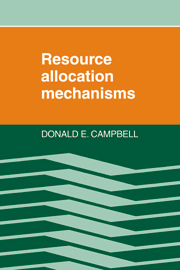Book contents
- Frontmatter
- Contents
- Preface
- Chapter 1 Introduction
- Chapter 2 Performance criteria
- Chapter 3 The Arrow–Debreu world
- Chapter 4 Uncertainty
- Chapter 5 Incentive compatibility
- Chapter 6 Existence of a competitive equilibrium
- Chapter 7 Welfare properties of the Walrasian mechanism
- Appendix 1 Elements of consumer choice
- Appendix 2 The Edgeworth exchange economy
- Appendix 3 Proof of the Shafer–Sonnenschein theorem
- References
- Author index
- Subject index
Chapter 6 - Existence of a competitive equilibrium
Published online by Cambridge University Press: 05 June 2012
- Frontmatter
- Contents
- Preface
- Chapter 1 Introduction
- Chapter 2 Performance criteria
- Chapter 3 The Arrow–Debreu world
- Chapter 4 Uncertainty
- Chapter 5 Incentive compatibility
- Chapter 6 Existence of a competitive equilibrium
- Chapter 7 Welfare properties of the Walrasian mechanism
- Appendix 1 Elements of consumer choice
- Appendix 2 The Edgeworth exchange economy
- Appendix 3 Proof of the Shafer–Sonnenschein theorem
- References
- Author index
- Subject index
Summary
Under ideal conditions an equilibrium of the Walrasian model of a private ownership market economy is Pareto optimal. The fact that these ideal conditions are not met without qualification in the real world does not vitiate the Walrasian approach to welfare economics, if only because Walrasian competitive equilibrium can be viewed as a standard to which policy-makers can aspire. The results of this book would be of little value, however, if it turned out that an equilibrium rarely exists. This chapter examines the conditions under which existence of equilibrium is assured.
Competitive behavior is assumed throughout. Other notions of equilibrium are more plausible in certain situations, but competitive behavior is important enough for a study of competitive equilibrium to constitute a useful introduction to the subject of existence of equilibrium. By assuming competitive behavior, we can be more specific about the features of a resource allocation mechanism. Accordingly, attention will be confined to mechanisms that require each agent to transmit a best response to the messages announced by others. A best response is one that would produce the best outcome for the decision-maker if the messages of others were to remain unchanged. If an agent's strategy has this property, his behavior is said to be competitive.
It is often claimed that proofs of existence of equilibrium constitute a mere mathematical flourish and are not worthy of study by anyone whose interest in economics stems from a desire to understand and prescribe for real-world phenomena.
- Type
- Chapter
- Information
- Resource Allocation Mechanisms , pp. 126 - 146Publisher: Cambridge University PressPrint publication year: 1987



